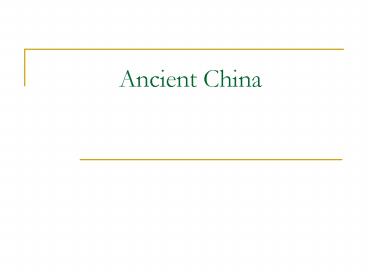Ancient China - PowerPoint PPT Presentation
1 / 9
Title:
Ancient China
Description:
Ancient China 4 Philosophies of Ancient China Buddhism: introduced from India along the Silk Road Confucianism: favored by rulers and adopted by the Han Emperor as ... – PowerPoint PPT presentation
Number of Views:186
Avg rating:3.0/5.0
Title: Ancient China
1
Ancient China
2
4 Philosophies of Ancient China
- Buddhism introduced from India along the Silk
Road - Confucianism favored by rulers and adopted by
the Han Emperor as the official state belief
system - Daoism stressed harmony with nature
- Legalism opposed Confucian belief that proper
behavior would solve societies problems.
Encouraged strict laws, severe punishments, a
strong central govt.
3
Dynastic ChinaZhou Dynasty (1027-256 BCE)
- Claimed they had a right to rule because they
possessed the Mandate of Heaven permission to
rule was granted by the divine power - Mandate of Heaven was later used to explain the
Dynastic Cycle a dynasty would remain in power
as long as it was providing good govt. - Dev. of silk and the beginnings of the
exportation of this resource - Dev. of bookmaking
4
(No Transcript)
5
Qin Dynasty (221 206 BCE)
- Unified China for the first time
- Known for warfare dev. Cavalry
- Favored Legalism the state had absolute control
and the nobility lost their power - Achievements standardized the language, writing,
currency, measurements - Great Wall of China built to protect from
Northern invasions - Punished any opposition and burned books
6
Han Dynasty (206 BCE 220 CE)
- Considered Chinas Golden Age
- Govt. focused on economic development the Silk
Road - stretched as far as Mesopotamia and India
(4000 miles) - main method of exchange btwn. China and other
cultures - main export silk
- imports glass, cloth, food, architecture,
gold, camels, Buddhism - Confucianism was the state belief system civil
service workers had to pass a Civil Service Exam
to get a job the Merit System - Achievements adv. in science, accurate clocks,
ship rudders, PAPER
7
- Tang Dynasty strict social structure developed,
dev. Of gunpowder, block printing, the first
vaccinations - Song Dynasty movable type printing
8
Cultural Diffusion of Chinese Culture
- Japan
- Retained political independence
- Copied Chinese models of government
- Adopted Confucian philosophy, historical writing,
and architecture (pagoda) - Japanese modified the Chinese system of writing
- Buddhism became the dominant religion in Japan
- Eventually, the influence of China declined in
the 9th century - Long-term impact Zen Buddhism, which is still a
dominant faith in Japan today
9
- Korea
- Influenced the most by China
- Became a Chinese colony
- Chinese rulers attempted to institute the Chinese
writing, examination system, and govt.
bureaucracy (process of Sinification) - Buddhism did take hold, Confucianism did not
- Trade and colonization offered access to Chinese
learning art, and goods - Vietnam (as an example of the influence on SE
Asia) - Chinese wanted Vietnam to control the rice
production in the country - The Vietnamese resisted the adoption of Chinese
more than other areas - Early attempts at conquest yielded trade, but no
political control - Some differences between the two cultures
language, dress, and the higher status of women - The Han will eventually conquer and Confucianism,
agricultural techniques, and military techniques
will take hold - Even after winning independence from China in the
10th century, Chinese bureaucracy and Buddhism
remained in place































